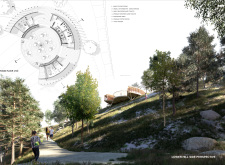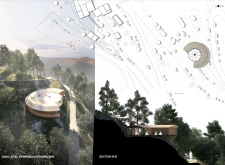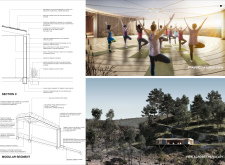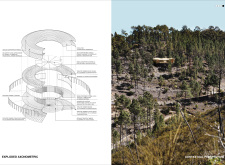5 key facts about this project
The architectural design is positioned within a natural landscape, focusing on blending functionality with community needs. It serves as a space dedicated to wellness, providing diverse offerings such as physiotherapy rooms, shower facilities, and a yoga studio. This design concept prioritizes accessibility and interaction among users, creating places where individuals can gather, recover, and engage in healthy practices.
Spatial Configuration
The ground floor layout consists of areas specifically designated for both male and female physiotherapy, showers, and shared spaces like a small kitchenette and a yoga studio. This thoughtful arrangement promotes ease of movement and enhances user experience by ensuring privacy while also encouraging socialization. The entrance area acts as a welcoming point, inviting users into the facility and establishing a sense of comfort.
Visual Integration
Perspectives from lower hillside and high-level views show how well the structure fits into the surrounding landscape. The design adapts to the natural topography, creating connections that enhance the relationship between indoor and outdoor environments. This approach aims to foster a sense of belonging and encourages users to appreciate their surroundings while using the facility.
Structural Elements
Key structural components are featured in sectional views, which illustrate the use of a treated timber roof frame along with treated timber structural elements. These selections highlight a balance between durability and visual appeal, ensuring the building can withstand time while looking good. Additional details, such as an insulated waterproof membrane and a steel tension tie bar system, strengthen the building's resilience and energy efficiency.
Sustainable Practices
Sustainability is a significant focus, shown through features such as heliartec wood appearance photovoltaic panels that resemble traditional timber shingles. This design choice merges modern technology with familiar architectural forms, making the building visually relatable. Also notable is the concealed copper rainwater gutter system, designed to collect water for greywater reuse. This approach reflects an effort to manage resources wisely and reduce the environmental impact of the building.
Design elements culminate in a thoughtful interaction between functional spaces and the natural environment, highlighted by insulated reglits with vertical timber fins that add texture and visual interest to the façade. The design invites users into a harmonious experience that emphasizes wellness and community.






















































